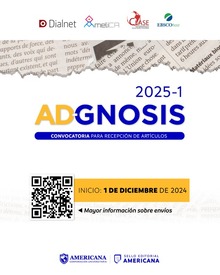Income, social classes and educational Inequality in Barranquilla, Colombia
DOI:
https://doi.org/10.21803/adgnosis.v7i7.296Keywords:
poverty, inequality and educational qualityAbstract
Inequality can be understood as a difference in terms of opportunities in access, possession, control and enjoyment of resources, rights and access to power, derived from different conditions. In Colombia, inequality manifests itself mainly in the distribution of income and monetary poverty. According to DANE figures, the coastal areas of Quibdo?, and Riohacha are the cities with the highest percentages of poverty with large settlements of black and indigenous population respectively. The following work tries to explain the existing correlation between the socioeconomic stratum and inequality in education, as this variable influences the performance of education through the results obtained in the Saber test11 in the city of Barranquilla. From the methodological point of view, multiple regression by ordinary least squares is used, in order to identify those variables that are significant in explaining the results of the educational quality tests for the case of Barranquilla. The main findings of this research confirm the positive effect that income or social position has on the academic results obtained by students in the state test. That is to say that the family backgraund is the main determinant of the quality of learning.
Downloads
References
Antón, A. (2014). Una desigualdad intolerable. Cuaderno de trabajo. Departamento de Sociologi?a. Universidad Auto?noma de Madrid.
DANE. (2017). Pobreza y Desigualdad. Recuperado de:
https://www.dane.gov.co/index.php/estadisticas-por-tema/ pobreza-y-condiciones-de-vida/pobreza-y-desigualdad.
García, M. Espinosa, R. Jime?nez, F. & Parra, J. (2013). “Separados y desiguales. Educacio?n y clases sociales en Colombia”. Coleccio?n DeJusticia.
Gaviria, A. y Barrientos, J. H. (2001). “Calidad de la educación y rendimiento académico en Bogota?”. Coyuntura Social, 24, 111-127.
Lee, J. W. y Barro, R. J. (2001). “Schooling quality in a cross-section of countries”. Econo?mica. 68(272): 465-488.
Roemer, (1998). “Igualdad de oportunidades”. Isegori?a, 18, 71- 87.
Piñeros, L. y Rodriguez, A. (1999). School Inputs in Secondary Education and their Effects on Academic Achievement: A Study in Colombia (No. 36). Washington, D.C.: Banco Mundial.
Presidente de la Republica de Colombia. (17 de marzo de 2010). Arti?culo 1. Por el cual se reglamenta el examen de estado de la educacio?n media, ICFES – SABER 11. Decreto 869.
Sánchez, F. y Díaz, A. M. (2005). Los efectos del conflicto armado en el desarrollo social colombiano, 1990-2002. Bogota?: Universidad de los Andes.
Downloads
Published
Versions
- 2023-02-03 (2)
- 2018-01-25 (1)
Issue
Section
License
Copyright (c) 2018 ADGNOSIS

This work is licensed under a Creative Commons Attribution-NonCommercial-NoDerivatives 4.0 International License.






